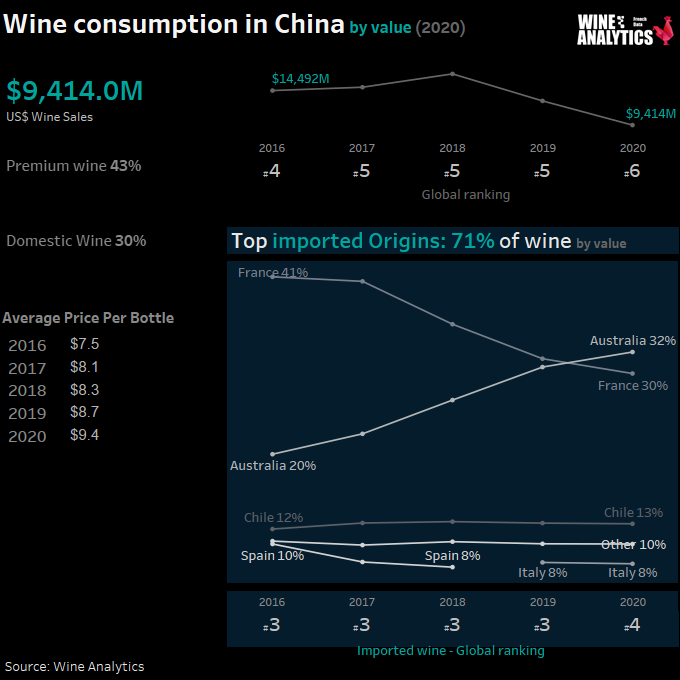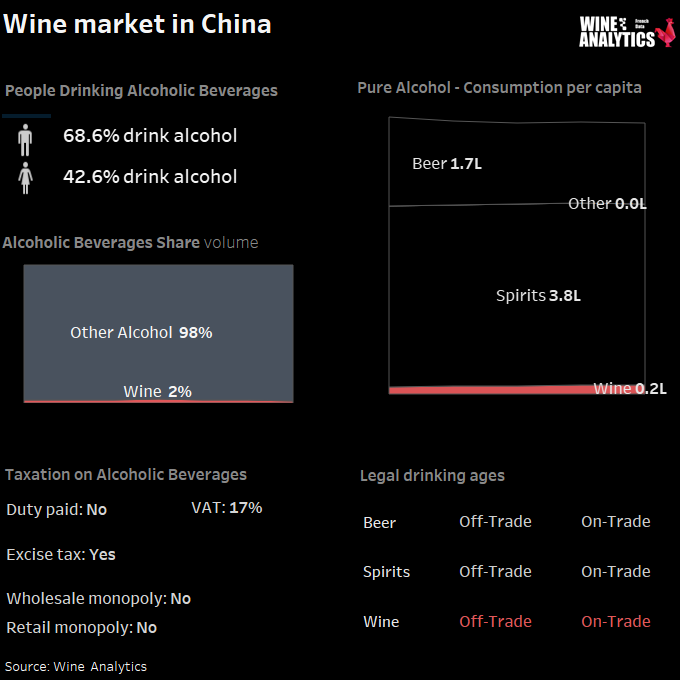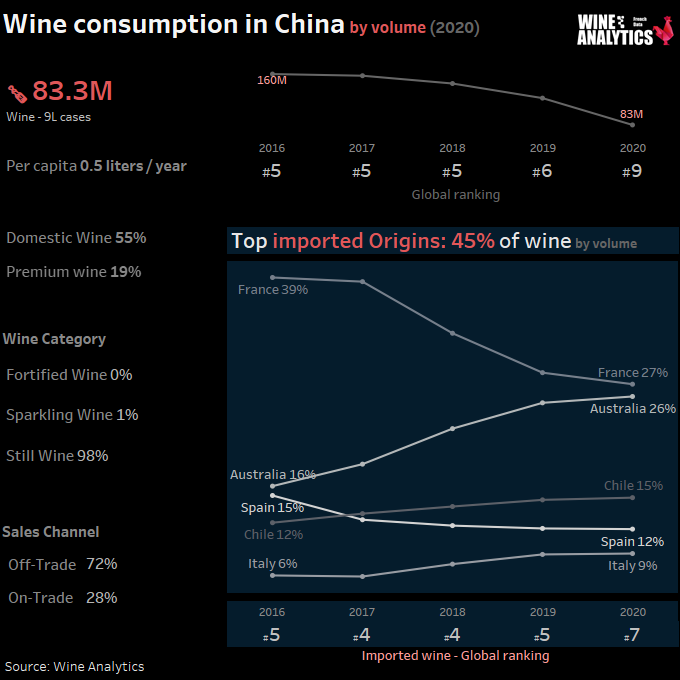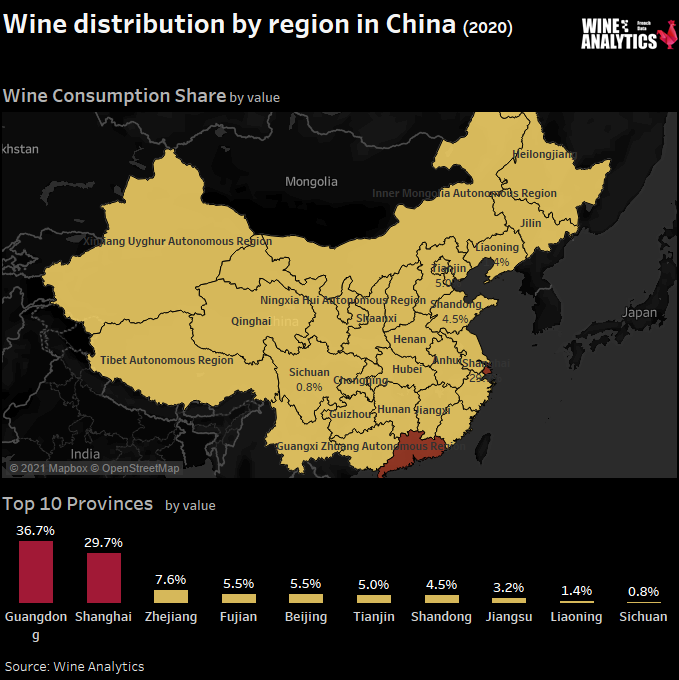In 1996, when then Chinese premier Li Peng praised the health benefits of wine during China’s National People’s Congress, it sent an unmistakable signal to the country’s officials and politically savvy wine merchants. That was a generation ago, when China’s wine consumption, particularly classified Bordeaux, was used for gifting and to lubricate business meals and banquets.
RATE THE CHINESE WINE MARKET ATTRACTIVENESS
2013 China’s age of wine
There is one thing that is clear about China’s wine market: its boundless promise is matched with equally boundless uncertainty. Wine imports soared; by the end of 2013, the Chinese were drinking more red wine than the French. But the fast rise of wine meant an equally dramatic collapse at the whim of political winds. At the beginning of 2013, Beijing’s new leadership cracked down on luxurious spending and wasteful official banquets; wine sales, particularly of fine wines, dried up. Merchants were stuck with gluts that would take years to deplete.
One of the main impacts of the anti-corruption clampdown is that it accelerated a shift from luxury gifting and prestige-driven wine consumption to more value-driven New World wines. A key beneficiary of this trend is Australia. By the summer of 2019, Australia had overtaken France to become China’s biggest wine supplier, taking up close to 40% market share by value. That however did not last long. China slapped a whopping 218% tariff on Australian wines in March 2021, effectively ending Australia’s wine exports to its most profitable market.
Read also China, wine is moving away from growth

In the first five months of 2021, as a result of the crippling 218% tariff levied on Australian wines for a five-year period, Australian wine exports to China dropped 81% in value and 84% in volume, bringing its overall market share down to 7% from close to 40%. France has already overtaken Australia to become the country’s biggest supplier, followed by Chile, Italy and Spain, according to the latest Chinese customs data.
Despite Li Peng’s championing of wine back in the 1990s, China’s drinks consumption is still heavily skewed towards baijiu, the ancient grain-based Chinese spirit. Baiju, along with beer, traditional Chinese yellow wine and other spirits, accounts for at least 90% of market share. Post-pandemic, baijiu sales have surged. One explanation is that in uncertain times, consumers lean to what is familiar (baijiu’s origins date back 5000 years).
This is not to say the wine market has no potential. The latest national census shows the country has over 900 million urban residents with high disposable income. As Chinese wine consumption moves away from speculative and prestige drinking and becomes more stable as it is taken up by the burgeoning middle class, the wine market size is expected to expand.

Overall wine consumption decreases in 2020
In 2020, the country’s overall wine consumption dropped by 17.4%.
The strict lockdown measures in the first quarter of the year certainly played a role. But unlike in the US or Europe, where strong off-trade wine sales helped compensate losses on trade, in China this failed to replicate. The country’s wine consumption is heavily concentrated on restaurants, hotels, bars and other on-trade premises while home consumption was limited.
In China there are over 7.1 million full-service restaurants, 18.2 million fast food restaurants and 404,000 street food stalls, according to 2019 data. In the first half of 2020, restaurants and bars were forced to close or operate within limited hours. In the month of February restaurant and bar closures over Chinese New Year lost wine merchants their most important wine sales period (Chinese New Year wine sales can contribute to as much as 30% of annual revenue for some companies).
5700 bars were forced to close in 2020, according to Chinese research company Zhiyan.
Imported wines take over from domestic
China’s wine market has been slowing down since 2018, a result of the country’s slowing economy and the protracted China-US trade war. The 2020 pandemic significantly complicates this picture.
The country’s imported wine dropped by 27% in value to US$1.95bn (€1.6bn) last year, according to customs data. This is a sharp decline for the second year in a row: the accelerated growth that we have seen in the past seems to have come to an end. It should be noted that compared to domestically-produced wine, imported wine grew markedly from US$2.03bn in 2015 to 2019’s US$2.43bn – even allowing for the distorting effect of the pandemic it was still growing up to 2020.
Domestic wine production has been on a downward spiral for five years: 2020 production was less than half that of 2016. Data compiled from the country’s 155 leading wineries showed that sales revenue plunged from RMB46bn (US$7.14bn) in 2015 to RMB14.5bn (US$2.25bn) in 2019, according to China Alcoholic Drinks Association (CADA), the country’s official drinks regulatory body.
China’s domestic wine production has been in decline for five consecutive years since 2015. How this sector will develop is uncertain. The new data shows the country’s production volume at 4.13 million hectoliters in 2020, compared with 4.51 mhl in 2019 – about 35% of the volume of 2015. One explanation is that low yields and high costs have driven out early investors in the sector. Structural problems such as difficult climate conditions, technical constraints, and low productivity facing wineries are also making Chinese wines less competitive against imported wines
| 2015 | 2016 | 2017 | 2018 | 2019 | 2020 |
| 11.60ml | 11.30ml | 10.01ml | 6.29ml | 4.51ml | 4.13ml |

Australia, France and Chile are the leaders in China’s imported wine market, taking up about 68% share. Shortly after the punitive tariffs came into effect on Australian wines, France has reclaimed its top spot as China’s No.1 wine exporter based on Q1 customs data.
The Chinese government has reduced VAT on imported wines twice in the past three years, from 17% in 2018 to 13% in 2019. For domestic wine producers, it was a different story. Years of lobbying the government to cut excise taxes on domestic wines advocated by the country’s biggest wine producer Changyu and officials from China’s premier wine region Ningxia went unheeded. This is part of the reason imported wines – particularly from Australia and Chile, which both enjoyed zero import tariffs – are often more competitive compared with Chinese wines. The import tariff remains at 14% and excise tax at 10%. These three taxes combined result in an effective tax rate of 43% for bottled wines and 50% for bulk wine.
French wines, particularly Bordeaux, have consistently fared well with the country’s fine wine drinkers. Bordeaux became a favourite among wealthy Chinese for gifting and and as a status symbol. By 2009 in the midst of the global financial crisis, China proved to be Bordeaux’s main En Primeur buyer. The En Primeur frenzy though has slowed in the past few years, as the overheated economy cools. Merchants who dived in over the 2009 and 2010 vintages were more cautious with spending amid slowing economy.
Chilean wines are gaining popularity in China. For a long time Chile was propelled by bulk wine exports, which are often mixed with domestically-produced wines. More recently the country’s top brands have built a steady following among China’s fine wine lovers.
Which types of wine are the most popular?
In Chinese, the word for “wine” translates as “red wine”. It’s no surprise then that the wine market is heavily skewed towards red; a 2018 Vinexpo report estimated that 90% of the wines consumed in the country are red wines. One of the main reasons for this is the perceived health benefit of red wine; another important consideration is that the colour red, associated as it is with wealth, festivity and power, is auspicious in Chinese culture.
As the market matures, shares of white wines, Champagne, sparkling and rosé are expected to grow. Additionally, the low-alcohol category is emerging as a new growth driver. A 2021 report released by AliResearch, the research arm of Alibaba, found the low-alcohol category is gaining ground, driven by female drinkers aged between 18 and 34, most of whom are middle-class office workers, working mothers, and Gen Z consumers.
Off-dry and semi-sweet wines are particularly popular among female consumers in the 25-30 age group, according to CBNData’s young drinks consumer report released in 2020. Sales of dry wines still dominate but off-dry and semi-sweet wines showed the biggest growth online last year. Moscato, as wine merchants would testify, is a crowd-pleaser.
One-third of China’s wine consumers live in Guangdong

China’s 52 million wine drinkers live mainly in the most developed and populous “first tier” cities such as Shanghai, Beijing, Guangzhou, Shenzhen and Chengdu. Drinkers aged between 20 and 34 are the main drivers for drinks consumption, according to CADA. Guangdong province boasts the country’s highest GDP and with major cities such as Shenzhen and Guangzhou, it is the country’s biggest bottled wine consumer by value, accounting for roughly 30% of the country’s overall wine import value. This is due in large part to residents’ high average disposable income and its close ties with Hong Kong on its southern borders, a mere 50km from Shenzhen.
Data from the Guangdong Alcoholic Drinks Association showed that premium drinks priced RMB600 (US$93) or above generated a total of RMB19bn (US$2.9 bn) in sales last year, a 26.7% increase over the previous year. This was despite months of strict lockdown measures that heavily affected on-trade sales. For bulk wine, Shandong province in eastern China is the biggest market.
One-third of Chinese wine sales are online
Some 30% of wine sales in China are generated online, a trend driven by tech-savvy millennials and one that is expected to grow. Today’s Chinese wine consumers are seconds away from connecting with wine merchants. The country has 710m online shoppers, of which 707m are mobile shoppers as of March 2020, a growth that has been accelerated by the pandemic, according to CNNIC.
China’s most popular social media app WeChat, owned and developed by tech giant Tencent, today has 1.15bn monthly active users (in a country of 1.4bn people). Sina Weibo, similar to Facebook, has over 400m monthly active users. Bytedance, the parent company that owns TikTok (or Douyin in Chinese), has some 800m users worldwide. Its competitor Kuaishou, another homegrown video streaming app, has 400m monthly active users.
This comprehensive network of Chinese-language social media platforms is intrinsically woven into the country’s leading e-commerce platforms, Alibaba-owned Tmall.com, Tencent-owned JD.com, and Pinduoduo. The three platforms combined would take up close to 90% of China’s overall e-commerce market. The country’s mammoth e-commerce market also spawned a unique and effective selling channel – livestreaming. Alibaba, by far the country’s largest e-commerce operator, and JD.com dominate the livestreaming market with 80% market share.
| Rank | Platform | Market Share |
| 1 | Tmall | 50.1% |
| 2 | JD.com | 26.5% |
| 3 | Pinduoduo | 12.8% |
| 4 | Suning | 3.0% |
| 5 | Wei Pin HUi | 1.8% |
| 6 | Other | 5.8% |
Choose the most appropriate importer and influencer
There are about 70 wine importers with annual revenues above US$5m. At the time of going to press, data is not available on how many wine importers, wholesalers and retailers survived 2020. According to CADA, there were 6,411 bottled wine importers, but that number shrank to 4,175 within just the first five months of 2019, squeezed by soft consumer demand and a slowing economy.
Given China’s size and scale, there are regional wine importers that focus more on local and regional markets. Beijing Ao Bi An is known for its network in eastern China. Fujian Feng Lian in southern China covers an extensive network in affluent Fujian and Shanghai markets.
| Rank | Wine Importer |
| 1 | ASC Fine Wines |
| 2 | COFCO Wine and Wine International |
| 3 | Changyu Pioneer Wine Company |
| 4 | Torres China |
| 5 | Summergate Wine and Spirits |
| 6 | 1919 Wine and Spirits |
| 7 | Moet Hennessy Diageo |
| 8 | EMW Wines |
The most popular influencers reach millions of wine drinkers
Influencers with millions of followers who can infuse practical information with humour and personality during livestreaming sessions are converting viewership into sales.
| Rank | Influencer | Followers on Sina Weibo |
| 1 | Viya | 17m |
| 2 | King of Lipsticks (Li Jlaql) | 9m |
| 3 | Lady Pengouin (Wang Shenghan) | 1.4m |
| 4 | Terry Xu | 450,000 |
| 5 | Li Demel | 300,000 |
| 6 | Julien Boulard | 95,000 |
| 7 | Lu Yang | 90,000 |
The country’s top livestreamers are Viya, and Li Jiaqi, who is known as “King of Lipsticks”. Both worked with state-owned Chinese winery GreatWall Winery and sold thousands of cases within a minute.
In the wine sector, the most influential personality is a 32-year-old woman called Wang Shenghan, aka Lady Penguin. Though wine is not yet the main source of her company revenue, her marketing-savvy and video-driven wine content on social media platforms such as Douyin, Weibo and WeChat have gained her millions of followers. On Douyin, the Chinese version of TikTok, she talks to her more than 3m followers about such things as the difference between a red wine glass and a white wine glass, how to hold a decanter, or how to choose wine based on lipstick colours. She describes the Merlot grape variety as a “friend next door”, and Riesling as a “fairy in a white cotton dress”. Her shop on Tmall.com is frequently ranked among the top 10 best-performing wine stores during the platform’s annual Global Wine and Spirits Festival.
Julien Boulard MW, fluent in Chinese, specialises in wine education and marketing and runs his wine company Zhulian Wines from his base in southwestern Guangxi province.
Lu Yang MS, China’s only Master Sommelier, consults for Shangri-la Hotels and Resorts. Lu also founded Grapea & Co, specialising in education and marketing.
Terry Xu, founder of wine consulting company Aroma Republic, is another personality active in the wine scene through education and wine communications.
Li Demei, one of the country’s most influential oenologists, dedicates his time to wine education and Chinese wine promotion. There are a few Chinese language wine publications that have built a solid audience, more so than English publications such as Decanter or Wine Spectator. Trade-focused Wine Business Observer, Sommelier Magazine and Taste Spirit are among some of the most read Chinese language wine media within China.

In the world of wine, the most influential key opinion leaders (KOLs) are invariably not traditional wine professionals.